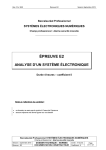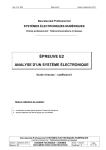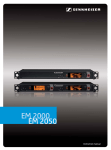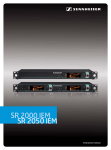Download Sennheiser EM 300 G3 - 01-09 Instruction manual
Transcript
EM300 Instruction manual Contents Contents Important safety instructions ........................................................................................................................ 2 The EM 300 G3 rack-mount receiver .............................................................................................................. 4 The frequency bank system ...................................................................................................................... 4 Delivery includes ............................................................................................................................................. 5 Product overview ............................................................................................................................................ 6 Overview of the EM 300 receiver .............................................................................................................. 6 Overview of the displays ........................................................................................................................... 7 Putting the receiver into operation ............................................................................................................... 8 Preparing the receiver for use ................................................................................................................... 8 Connecting an amplifier/mixing console ................................................................................................ 11 Connecting receivers in a network .......................................................................................................... 12 Connecting the mains unit ...................................................................................................................... 12 Using the receiver ......................................................................................................................................... 12 Switching the receiver on/off ................................................................................................................. 13 Monitoring the audio signal via headphones ......................................................................................... 13 Synchronizing a transmitter with the receiver ....................................................................................... 13 Deactivating the lock mode temporarily ................................................................................................ 14 Muting the audio signal .......................................................................................................................... 15 Selecting a standard display ................................................................................................................... 15 Using the operating menu ........................................................................................................................... 16 The buttons ............................................................................................................................................. 16 Overview of the operating menu ............................................................................................................ 16 Adjustment tips ............................................................................................................................................ 18 Synchronizing a transmitter with the receiver ....................................................................................... 19 Cleaning the receiver .................................................................................................................................... 21 If a problem occurs ... .................................................................................................................................... 21 Specifications ................................................................................................................................................ 23 Manufacturer Declarations ........................................................................................................................... 25 For more detailed information on the individual sections of this instruction manual, visit the EM 300 G3 product page on our website at www.sennheiser.com. There you can also view an animated instruction manual. 1 Important safety instructions Important safety instructions • Read this instruction manual. • Keep this instruction manual. Always include this instruction manual when passing the device and the mains unit on to third parties. • Heed all warnings and follow all instructions in this instruction manual. • Only clean the device and the mains unit when they are not connected to the mains. Use a cloth for cleaning. • Refer all servicing to qualified service personnel. Servicing is required if the device or the mains unit have been damaged in any way, liquid has been spilled, objects have fallen inside, the device or the mains unit have been exposed to rain or moisture, do not operate properly or have been dropped. • WARNING: To reduce the risk of fire or electric shock, do not use the device and the mains unit near water and do not expose them to rain or moisture. Do not place objects filled with liquids, such as vases or coffee cups, on the device. • Only use the supplied mains unit. • Unplug the mains unit from the wall socket – to completely disconnect the device from the mains, – during lightning storms or – when unused for long periods of time. • Only operate the mains unit from the type of power source specified in the chapter “Specifications” (see page 23). • Ensure that the mains unit is – in a safe operating condition and easily accessible, – properly plugged into the wall socket, – only operated within the permissible temperature range, – not covered or exposed to direct sunlight for longer periods of time in order to prevent heat accumulation (see “Specifications” on page 23). • Do not block any ventilation openings. Install the device and the mains unit in accordance with the instructions given in this instruction manual. • Do not install the device and the mains unit near any heat sources such as radiators, stoves, or other devices (including amplifiers) that produce heat. • Only use attachments/accessories specified by Sennheiser. • When replacement parts are required, only use replacement parts specified by Sennheiser or those having the same characteristics as the original part. Unauthorized substitutions may result in fire, electric shock, or other hazards. • Do not overload wall outlets and extension cables as this may result in fire and electric shock. 2 Important safety instructions • Danger due to high volumes This device is capable of producing sound pressure exceeding 85 dB(A). 85 dB(A) is the sound pressure corresponding to the maximum permissible volume which is by law (in some countries) allowed to affect your hearing for the duration of a working day. It is used as a basis according to the specifications of industrial medicine. Higher volumes or longer durations can damage your hearing. At higher volumes, the duration must be shortened in order to prevent hearing damage. The following are sure signs that you have been subjected to excessive noise for too long a time: – You can hear ringing or whistling sounds in your ears. – You have the impression (even for a short time only) that you can no longer hear high notes. Intended use Intended use of the ew 300 G3 series devices includes: • having read these instructions especially the chapter “Important safety instructions”, • using the devices within the operating conditions and limitations described in this instruction manual. “Improper use” means using the devices other than as described in these instructions, or under operating conditions which differ from those described herein. 3 The EM 300 G3 rack-mount receiver The EM 300 G3 rack-mount receiver The EM 300 G3 rack-mount receiver is part of the evolution wireless series generation 3 (ew G3). With this series, Sennheiser offers high-quality state-of-the-art RF transmission systems with a high level of operational reliability and ease of use. Transmitters and receivers permit wireless transmission with studio-quality sound. Features of the evolution wireless 300 G3 series: • Optimized PLL synthesizer and microprocessor technology • HDX noise reduction system • Pilot tone squelch control • True diversity technology • Switching bandwidth of 42 MHz • Safe configuration of a multi-channel system via a network • Scan function (Easy Setup) for scanning the frequency banks for unused channels The frequency bank system Please note: Frequency usage is different for each country. Your Sennheiser partner will have all the necessary details on the available legal frequencies for your area. The receiver is available in 6 UHF frequency ranges with 1,680 receiving frequencies per frequency range: Range A: Range G: Range B: Range C: Range D: Range E: 516 – 558 566 – 608 626 – 668 734 – 776 780 – 822 823 – 865 Each frequency range (A–E, G) offers 26 frequency banks with up to 24 channels each: Channel 1 – frequency preset Channel 2 – frequency preset Frequency bank 1... 20 Channel 24 – frequency preset Channel 1 – freely selectable frequency Channel 2 – freely selectable frequency Frequency bank U1 ... U6 Channel 24 – freely selectable frequency 4 Delivery includes Each of the channels in the frequency banks “1” to “20” has been factory-preset to a fixed receiving frequency (frequency preset). The factory-preset frequencies within one frequency bank are intermodulation-free. These frequencies cannot be changed. For an overview of the frequency presets, please refer to the supplied frequency information sheet. Updated versions of the frequency information sheet can be downloaded from the EM 300 G3 product page on our website at www.sennheiser.com. The frequency banks “U1” to “U6” allow you to freely select and store receiving frequencies. It might be that these receiving frequencies are not intermodulation-free (see page 21). Delivery includes The packaging contains the following items: 1 EM 300 G3 rack-mount receiver 1 NT 2-3 mains unit with one country adapter 2 rod antennas 1 GA 3 rack adapter 1 instruction manual 1 frequency information sheet 1 RF licensing information sheet 4 device feet 5 Product overview Product overview Overview of the EM 300 receiver A PEAK 40 30 20 10 RF 0 -10 -20 -30 -40 AF B.Ch: 20.24 ew300 G3 543.200 MHz SKM300 EQ: P + 12dB MUTE B A Operating elements – front panel B Headphone output, ¼” (6.3 mm) jack socket ( ) Headphone volume control 쐋 button, backlit Infra-red interface Display panel, backlit in orange Jog dial STANDBY button, serves as the ESC (cancel) key in the operating menu Operating elements – rear panel Antenna input II (ANT II) with remote power supply input, BNC socket Type plate Antenna input I (ANT I) with remote power supply input, BNC socket Audio output (AF OUT UNBAL), ¼” (6.3 mm) jack socket, unbalanced Audio output (AF OUT BAL), XLR-3M socket, balanced LED (yellow) for network activity indication LAN socket (ETHERNET RJ 45) Cable grip for power supply DC cable DC socket (DC IN) for connection of NT 2-3 mains unit 6 Product overview Overview of the displays After switch-on, the receiver displays the standard display “Receiver Parameters”. For further illustrations and examples of the different standard displays, please refer to page 15. This standard display displays the operating states of the receiver and provides the most important information on the received transmitter – provided the linked transmitter supports this function. PEAK 40 30 20 10 RF 0 -10 -20 -30 -40 AF B.Ch: 20.24 ew300 G3 543.200 MHz EQ: SKM300 P + 12dB MUTE Display Meaning RF level “RF” (Radio Frequency) Diversity display: Antenna input I is active 40 30 Audio level “AF” (Audio Frequency) Antenna input II is active 10 RF signal level: Field strength of the transmitted signal RF Squelch threshold level 20 PEAK 0 -10 -20 -30 -40 AF Modulation of the transmitter with peak hold function When the level display for audio level shows full deflection, the audio input level is excessively high. When the transmitter is overmodulated frequently or for extended periods of time, the “PEAK” display is shown inverted. 햴 Frequency bank and channel Current frequency bank and channel number Frequency Current receiving frequency Name Freely selectable name of the receiver Pilot tone “P” Activated pilot tone evaluation Equalizer setting Current equalizer setting Output gain (see page 17) Current output gain of the audio signal available at the ¼” (6.3 mm) jack socket / XLR-3M socket Muting function “MUTE” (see page 15) Receiver is muted Receiver does not output an audio signal (see page 22). 7 Putting the receiver into operation Display Meaning Transmitter type Product name of the linked ew G3 transmitter The product name is displayed only if the linked transmitter supports this function. Transmitter battery status Charge status: approx. 100% approx. 70% approx. 30% battery icon is flashing; charge status is critical When the battery charge status is critical, “LOW BATT” flashes in alternation with the standard display. Lock mode icon (see page 14) Lock mode is activated Putting the receiver into operation Preparing the receiver for use Setting up the receiver on a flat surface Place the receiver on a flat, horizontal surface. Please note that the device feet can leave stains on delicate surfaces. The rack mount “ears” are designed to help protect the operating elements from damage or deformation, e.g. if the receiver is dropped. Therefore, fasten the rack mount “ears”, even if you do not want to rack mount your receiver. Mounting the rack mount “ears” To fasten the rack mount “ears” : 왘 Unscrew and remove the two recessed head screws (M4x8) on each side of the receiver (see diagram). 왘 Secure the rack mount “ears” to the sides of the receiver using the previously removed recessed head screws (see diagram). 8 Putting the receiver into operation Fitting the device feet Do not fit the device feet when mounting the receiver into a 19” rack. 왘 Clean the base of the receiver where you want to fix the device feet. 왘 Fit the device feet to the four corners of the receiver. Connecting the rod antennas The supplied rod antennas are suitable for use in good reception conditions. 왘 Connect the rod antennas (see diagram). 왘 Align the antennas in a V-shape. When using more than one receiver, we recommend connecting remote antennas and, if necessary, using Sennheiser antenna accessories. Fore more information, visit the ew G3 product page at www.sennheiser.com. 9 Putting the receiver into operation Mounting the receiver into a 19” rack Do not fit the device feet when mounting the receiver into a 19” rack. CAUTION! Risks when rack mounting the receiver! When installing the device in a closed or multi-rack assembly, please consider that, during operation, the ambient temperature, the mechanical loading and the electrical potentials will be different from those of devices which are not mounted into a rack. 왘 Make sure that the ambient temperature within the rack does not exceed the permissible temperature limit specified in the EM 100 G3 specifications. 왘 Ensure sufficient ventilation; if necessary, provide additional ventilation. 왘 When connecting to the power supply, observe the information indicated on the type plate. Avoid circuit overloading. If necessary, provide overcurrent protection. 왘 When rack mounting, please note that intrinsically harmless leakage currents of the individual mains units may accumulate, thereby exceeding the allowable limit value. As a remedy, ground the rack via an additional ground connection. Rack mounting one receiver 왘 Secure the rack mount “ears” (supplied with the GA 3 rack adapter) to the receiver as described on page 8. 왘 Secure the blanking plate to one of the rack mount “ears” using two recessed head screws (M 6x10) (see left-hand diagram). 왘 Connect the antennas. There are two ways to connect the antennas: – You can connect the rod antennas to the rear of the receiver (see page 9). In this case, insert the two blanking plugs into the holes of the blanking plate (see lefthand diagram). – You can use the AM 2 antenna front mount kit (optional accessory) and mount the rod antennas to the front of the receiver (see right-hand diagram). When using more than one receiver, we recommend connecting remote antennas and, if necessary, using Sennheiser antenna accessories. For more information, visit the ew G3 product page at www.sennheiser.com. 왘 Slide the receiver with the mounted blanking plate into the 19” rack. 왘 Secure the rack mount “ears” and the blanking plate 왘 Align the antennas in a V-shape. 10 to the 19” rack. Putting the receiver into operation Rack mounting two receivers When rack mounting two receivers side by side, you can only front mount the antennas when using the ASA 1 antenna splitter in conjunction with the AM 2 antenna front mount kit and an additional GA 3 rack adapter. For more information, visit ew G3 product pages at www.sennheiser.com. We recommend using remote antennas. To mount two receivers into a rack using the GA 3 rack adapter: 왘 Place the two receivers side by side upside-down onto a flat surface: 왘 Secure the jointing plate to the receivers using six recessed head screws (M 3x6). 왘 Secure the rack mount “ears” to the receivers as described on page 8. To mount the antennas: 왘 Use remote antennas, if necessary in conjunction with the ASA 1 antenna splitter. For more information, visit ew G3 product pages at www.sennheiser.com. To mount the receivers into the 19” rack: 왘 Slide the receivers into the 19” rack. 왘 Secure the rack mount “ears” to the 19” rack. Connecting an amplifier/mixing console The receiver’s ¼” (6.3 mm) jack socket and the XLR-3M socket are connected in parallel. 왘 Use a suitable cable to connect the amplifier and/or the mixing console to the ¼” (6.3 mm) jack socket or the XLR-3M socket (see also page 25). 왘 Via the operating menu, adjust the audio output level (AF OUT) of the receiver to the input of the amplifier or mixing console (see page 17). The audio output level is adjusted via the operating menu and is common for both sockets. 11 Using the receiver Connecting receivers in a network You can connect several receivers in a network. The receivers are remote controlled via a PC running the supplied “Wireless Systems Manager” (WSM) software. This software will assist in the quick and safe configuration of multi-channel systems. WSM For further information on multi-channel operation and on downloading the software, visit the EM 300 G3 product page on our website at www.sennheiser.com. 왘 Connect a standard network cable (at least Cat 5) to the LAN socket of the receiver. 왘 Connect your receivers to an Ethernet switch. 왘 Connect a computer to the Ethernet switch. When a receiver is properly connected to the Ethernet switch or the PC, the yellow LED at the rear of the receiver lights up. Connecting the mains unit Only use the supplied mains unit . It is designed for the receiver and ensures safe operation. 왘 Insert the yellow connector of the NT 2-3 mains unit receiver. into the yellow socket of the 왘 Pass the cable of the mains unit through the cable grip . 왘 Slide the supplied country adapter ! onto the mains unit . 왘 Plug the mains unit into a wall socket. The STANDBY button is backlit in red. ! Using the receiver To establish a transmission link, proceed as follows: 1. Switch the receiver on (see below). 2. Switch the transmitter on (see the instruction manual of the transmitter). The transmission link is established and the display backlighting of the receiver changes from red to orange. It is vital to observe the notes on frequency selection on page 19. If you cannot establish a transmission link between transmitter and receiver: 왘 Make sure that transmitter and receiver are set to the same frequency bank and to the same channel. 왘 If necessary, read the chapter “If a problem occurs ...” on page 22. 12 Using the receiver Switching the receiver on/off To switch the receiver on: 왘 Briefly press the STANDBY button . The receiver switches on and the “Receiver Parameters” standard display appears. ew300 G3 200 MHz SKM300 E To switch the receiver to standby mode: 왘 If necessary, deactivate the lock mode (see page 14). 왘 Keep the STANDBY button pressed until “OFF” appears on the display panel. The display panel then turns off. • When in the operating menu, pressing the STANDBY button will cancel your entry (ESC function) and return you to the current standard display. • The STANDBY button is backlit in red both during operation and in standby mode. To completely switch the receiver off: 왘 Disconnect the receiver from the mains by unplugging the mains unit from the wall socket. The backlighting of the STANDBY button goes off. Monitoring the audio signal via headphones You can monitor the audio signal via the headphone output. CAUTION! Danger of hearing damage! Listening at high volume levels for long periods can lead to permanent hearing defects. 왘 Set the headphone volume control to the minimum position before putting the headphones on. 왘 Set the headphone volume control to the minimum position. 4 3 2 1 R 왘 Connect headphones with a ¼” (6.3 mm) stereo jack plug to the headphone output . 왘 Gradually increase the volume and monitor the audio signal with the lowest possible volume. Synchronizing a transmitter with the receiver You can synchronize a suitable transmitter of the evolution wireless 300 series with the receiver. If the receiver is in ex works condition, the following parameters are transferred to the transmitter during synchronization: Setting Transferred parameters “Frequency Preset” Currently set frequency “Name” Freely selectable name currently set on the receiver “Pilot Tone” Current pilot tone setting of the receiver (“Inactive”/“Active”) 13 Using the receiver Via the “Sync Settings” submenu, you can adjust the parameters to be transferred to the transmitters (see page 18). To transfer the parameters: 왘 Switch the transmitter and the receiver on. 왘 Press the button 쐋 on the receiver. “Sync” appears on the display panel of the receiver. 왘 Place the infra-red interface of the transmitter (see the instruction manual of the transmitter) in front of the infra-red interface of the receiver . The parameters are transferred to the transmitter. When the transfer is completed, “ ” appears on the display panel. The receiver then switches back to the current standard display. To cancel the transfer: 왘 Press the STANDBY button on the receiver. “ ” appears on the display panel of the receiver. “ ” also appears if: – no transmitter was found or the transmitter is not compatible, – no transmitter was found and the synchronization process was canceled after 30 seconds, – you canceled the transfer. Deactivating the lock mode temporarily You can activate or deactivate the automatic lock mode via the “Auto Lock” menu item. If the lock mode is activated, you have to temporarily deactivate it In order to be able to operate the receiver: 왘 Press the jog dial. “Locked” appears on the display panel. 왘 Turn the jog dial. “Unlock?” appears on the display panel. 왘 Press the jog dial. The lock mode is temporarily deactivated: When you are in the operating menu The lock mode is deactivated as long as you are in the operating menu. When one of the standard displays is shown The lock mode is automatically activated after 10 seconds. The lock mode icon flashes prior to the lock mode being activated again. PEAK 40 30 20 10 RF 0 -10 -20 -30 -40 AF B.Ch: 20.24 ew300 G3 543.200 MHz SKM300 EQ: P + 12dB MUTE 14 Using the receiver Muting the audio signal To mute the audio signal: 왘 When one of the standard displays is shown on the display panel, press the STANDBY button. “RX Mute On?” appears on the display panel. 왘 Press the jog dial. The audio signal is muted. “RX Mute” flashes in alternation with the current standard display. The display panel is backlit in red. To unmute the audio signal: 왘 Press the STANDBY button. “RX Mute Off?” appears on the display panel. 왘 Press the jog dial. The muting is canceled and the display backlighting changes from red to orange again. Selecting a standard display 왘 Turn the jog dial to select the standard display: Contents of the display PEAK 40 30 20 10 RF 0 -10 -20 -30 -40 AF PEAK 40 30 20 10 RF 0 -10 -20 -30 -40 AF 543.200 MHz ew300 G3 SKM300 835 Standard P – 12dB MUTE B.CH: 20.24 ew300 G3 543.200 MHz SKM300 EQ: P + 12dB MUTE PEAK 40 30 20 10 RF 0 -10 -20 -30 -40 AF Soundcheck 20.24 ew300 G3 543.200 MHz Selectable standard display “Transmitter Parameters”* (transmitter type/microphone, inverted display) displays the microphone head (SKM only) and the transmitter type. For more information, refer to the instruction manual of your SK transmitter or SKM radio microphone. “Receiver Parameters” appears after switch-on of the receiver and displays the receiver parameters (see page 7). “Soundcheck” (display with additional function) displays the signal quality within the transmission area (see page 18). P MUTE * The reading of the transmitter parameters can take up to 2 minutes. If you synchronize your transmitter with the receiver(see page 13), the parameters are read out without delay. 15 Using the operating menu Using the operating menu The buttons Button Function of the button Press the STANDBY button • Switches the receiver on and off • Cancels the entry and returns to the current standard display (ESC function) • Mutes the receiver (special function, see page 15) Press the jog dial • Changes from the current standard display to the operating menu • Calls up a menu item • Enters a submenu • Stores the settings and returns to the operating menu Turn the jog dial • Selects a standard display • Changes to the next/previous menu item • Changes the setting of a menu item Overview of the operating menu For more detailed information on the operating menu, refer to the instruction manual of the EM 300. This instruction manual can be downloaded from the EM 300 product page at www.sennheiser.com. Main menu “Menu” Squelch Easy Setup Frequency Preset Name AF Out Equalizer AutoLock Advanced Extended menu Exit “Advanced Menu” “Easy Setup” Tune Sync Settings Pilot Tone Warnings LCD Contrast Reset IP-Address Software Revision Exit “Warnings” Reset List Current List Scan New List Exit AF-Peak Low RF-Signal RF Mute TX Mute RX Mute Low Battery Exit “SKM Settings/ SK Settings” Submenu “Sync Settings” SK Settings SKM Settings Exit Sensitivity Auto Lock Mute Mode RF Power Exit When one of the standard displays is shown on the display panel, you can get into the main menu by pressing the jog dial. The extended menu “Advanced Menu” and the submenus can be accessed via the corresponding menu items. 16 Using the operating menu Display Function of the menu item Main menu “Menu” Squelch Adjusts the squelch threshold Adjustment range: 5 to 25 dBμV in 2-dB steps, can be switched off Special function (for servicing purposes only): With the jog dial set to the “5 dB” setting, you switch the squelch off by turning the jog dial to the left and keeping it in this position. If you then turn the jog dial to the right, you switch the squelch on again. CAUTION! Danger of hearing damage and material damage! If you switch the squelch off or adjust the squelch threshold to a very low value, loud hissing noise can occur in the receiver. The hissing noise can be loud enough to cause hearing damage or overload the loudspeakers of your system! 왘 Always make sure that the squelch is switched on (see above). 왘 Before adjusting the squelch threshold, set the volume of the audio output level to the minimum. 왘 Never change the squelch threshold during a live transmission. Easy Setup Scans for unused frequency presets, releases and selects frequency presets Frequency Preset Changes the frequency bank and the channel Name Enters a freely selectable name AF Out Adjusts the audio output level Adjustment range: –24 dB to +24 dB, adjustable in 3-dB steps, 6 dB gain reserve Special function “gain reserve”: 왘 When you have adjusted a level of +18 dB, turn the jog dial to the right and keep it in this position until the next higher value appears. Equalizer Changes the frequency response of the output signal Auto Lock Activates/deactivates the automatic lock mode Advanced Calls up the extended menu “Advanced Menu” Exit Exits the operating menu and returns to the current standard display “Easy Setup” Reset List Releases all locked frequency presets and selects an unused frequency preset Current List Selects an unused frequency preset Scan New List Scans for unused receiving frequencies (frequency preset scan) Exit Exits the submenu “Easy Setup” and returns to the main menu Extended menu “Advanced Menu” Tune Sets the receiving frequencies for the frequency banks “U1” to “U6” Special function: Sets a channel and a receiving frequency for the frequency banks “U1” to “U6”: 왘 Select this menu item and call it up by pressing the jog dial until the channel selection appears. Sync Settings Activates/deactivates the parameters to be transferred to the transmitters Pilot Tone Activates/deactivates the pilot tone evaluation 17 Adjustment tips Display Function of the menu item Warnings Activates/deactivates the warning messages LCD Contrast Adjusts the contrast of the display panel Reset Resets the receiver IP-Address Adjusts the IP address of the receiver Software Revision Displays the current software revision Exit Exits the extended menu “Advanced Menu” and returns to the main menu Submenu “Sync Settings” SKM Settings Activates/deactivates the parameters to be transferred to the SKM radio microphones SK Settings Activates/deactivates the parameters to be transferred to the SK bodypack transmitters Exit Exits the submenu “Sync Settings” and returns to the extended menu “Advanced Menu” “SK Settings”/“SKM Settings” Here you can activate/deactivate the transfer of the following transmitter parameters: Sensitivity, Auto Lock, Mute Mode and RF Power (see page 13) “Warnings” Activates/deactivates warnings (color change and warning messages): AF-Peak Audio overmodulation Low RF-Signal RF signal is weak RF-Mute RF signal is too weak or no RF signal TX-Mute • Transmitter is muted or • no pilot tone RX-Mute Receiver is muted Low Battery Exit Charge status of the transmitter battery/the BA 2015 accupack is critical Exits the submenu “Warnings” and returns to the extended menu “Advanced Menu” Adjustment tips The operating menu allows you to make settings for your receiver and your transmitters. The soundcheck function of the “Soundcheck” standard display can be accessed without having to get into the operating menu. Doing a soundcheck By doing a soundcheck, you can check the reception area for field strength gaps (“dropouts”) which cannot be compensated for by the receiver’s diversity circuitry. You can do the soundcheck without the help of another person. 왘 Switch the transmitter on. 왘 On the receiver, change to the “Soundcheck” standard display. 18 Adjustment tips PEAK 40 30 20 10 RF 0 -10 -20 -30 -40 AF B.CH: 20.24 ew300 G3 PEAK 40 543.200 MHz 30 SKM300 EQ: P + 12dB MUTE 10 “Receiver Parameters” standard display 20 RF 0 -10 -20 -30 -40 AF Soundcheck 20.24 ew300 G3 543.200 MHz P “Soundcheck” standard display If no transmitter is being received or if the signal is below the squelch threshold level, “MUTE” appears. 왘 With the transmitter, walk up and down the transmission area. The receiver records the following parameters and displays them on the “Soundcheck” standard display: RF Max AF Max PEAK 40 30 20 10 RF RF Min 0 -10 -20 -30 -40 AF Soundcheck 20.24 ew300 G3 543.200 MHz Display Meaning RF Min Min. RF signal level: P RF Max What to do ... 왘 Check if the antennas and the antenna cables are correctly connected. • must be well above the squelch threshold level for 왘 Improve the position of the antennas. one of the two antennas 왘 If necessary, use antenna boosters. Max. RF signal level: • both antennas should reach 40 dBμV AF Max Max. audio level 왘 On your transmitter, adjust the audio level as high as possible without the level display for audio level showing full deflection (AF Max is at a level with the PEAK display). For more information, refer to the instruction manual of the transmitter. Synchronizing a transmitter with the receiver When synchronizing a transmitter with a receiver, please observe the following: 왘 Only use a transmitter and a receiver from the same frequency range (see the type plate on the transmitter and the receiver). 왘 Make sure that the desired frequencies are listed in the enclosed frequency information sheet. 왘 Make sure that the desired frequencies are approved and legal in your country and, if necessary, apply for an operating license. Synchronizing a transmitter with the receiver – individual operation Upon delivery, transmitter and receiver are synchronized with each other. However, if you cannot establish a transmission link between transmitter and receiver, you have to synchronize the channels of the devices: 왘 With the receiver, perform a frequency preset scan to scan the frequency banks for unused channels (“Scan New List”, see page 17). 19 Adjustment tips 왘 Select a channel on your receiver (“Current List”, see page 17). The receiving frequency of the channel must be approved and legal in your country (see above). 왘 Synchronize a transmitter with the receiver via the infra-red interface (see page 13). This establishes a transmission link between the transmitter and the receiver. Alternatively, you can set the channel on the transmitter manually: 왘 Make sure that you set the transmitter to the same frequency bank and the same channel as the receiver. For information on the setting options of the transmitter, refer to the instruction manual of the transmitter. Synchronizing transmitters with receivers – multi-channel operation Network operation In multi-channel operation, the receivers are remote controlled via a PC running the “Wireless Systems Manager” (WSM) software. Advantages of controlling the receivers via the “Wireless Systems Manager” (WSM) software: WSM • Detailed overview of all receiving channels • Remote control of all receivers in the network • Combination of receivers of different frequency ranges (see page 4) 왘 Connect the receivers in a network (see page 12). 왘 Launch the “Wireless Systems Manager” (WSM) software. 왘 To scan for unused receiving frequencies and to configure the receivers, proceed as described in the instruction manual of the “Wireless Systems Manager” (WSM) software. 왘 Set the linked transmitter to the selected frequency bank and to the selected channel either by synchronizing the transmitter with the receiver (see page 13) or by setting the frequency bank and the channel manually (see the instruction manual of the transmitter). Your multi-channel system is now set up. Operation without network 왘 Switch off all transmitters of your system that are to be automatically configured. Channels used by switched-on transmitters are displayed as “used”. 왘 With one of the receivers, perform a frequency preset scan to scan the frequency banks for unused channels (“Scan New List”, see page 17). 왘 Select a channel on this receiver (“Current List”, see page 17). The receiving frequency of the channel must be approved and legal in your country (see above). 왘 Synchronize a transmitter with the receiver via the infra-red interface (see page 13). This establishes a transmission link between the transmitter and the receiver. 왘 Repeat for the remaining transmitter and receiver pairs as described above. 20 Cleaning the receiver Alternatively, you can set the channel on the transmitter manually: 왘 Make sure that you set the transmitter to the same frequency bank and the same channel as the receiver. For information on the setting options of the transmitter, refer to the instruction manual of the transmitter. You can also freely select the receiving frequencies and store these frequencies in the frequency banks “U1” to “U6”. If you are using the frequency banks “U1” to “U6”, it might be that the receiving frequencies are not intermodulation-free: 왘 For possible frequency combinations, please refer to the frequency information sheet or calculate the frequencies (see below). If you want to use the frequency banks “U1” to “U6”: 왘 Make sure to use receivers of the same frequency range (see page 4 and the type plate of the receiver). 왘 Only use frequencies that are approved and legal in your country (see page 19). To ensure that the desired frequencies are intermodulation-free, proceed as follows: 왘 Calculate intermodulation-free frequencies using the “Sennheiser Intermodulation and Frequency Management (SIFM)” software (see www.sennheiser.com). 왘 Set each receiver to the same frequency bank. 왘 On one of the receivers, select a channel within this frequency bank (see page 17). 왘 Assign this channel one of the calculated receiving frequencies (see page 17). 왘 Synchronize a transmitter with the receiver (see page 13) OR 왘 Manually set the transmitter to the same frequency bank, channel and frequency that you set on the receiver. 왘 Repeat for the remaining transmitters and receivers as described above. Cleaning the receiver CAUTION! Liquids can damage the electronics of the receiver! Liquids entering the housing of the device can cause a short-circuit and damage the electronics. 왘 Keep all liquids away from the receiver. 왘 Before cleaning, disconnect the device from the mains. 왘 Use a slightly damp cloth to clean the receiver from time to time. Do not use any solvents or cleansing agents. 21 If a problem occurs ... If a problem occurs ... Problem Possible cause Possible solution Receiver cannot be operated, “Locked” appears on the display panel Lock mode is activated Deactivate the lock mode (see page 14). No operation indication No mains connection Check the connections of the mains unit. No RF signal Transmitter and receiver are not on the same channel Set the transmitter and receiver to the same channel. To do so, use the synchronization function (see page 19). Transmitter is out of range Check the squelch threshold setting (see page 17). Reduce the distance between transmitter and receiving antennas. RF signal available, no audio signal, “MUTE” appears on the display panel If “TX Mute” additionally appears on the display panel: transmitter is muted (“MUTE”) or transmitter doesn’t transmit a pilot tone Cancel the muting (see the instruction manual of the transmitter or see page 15). Receiver’s squelch threshold is adjusted too high Reduce the squelch threshold (see page 17). Switch the pilot tone transmission on the transmitter on. Switch the pilot tone evaluation on the receiver off. Reposition the antennas. Audio signal has a high Transmitter sensitivity is adjusted too level of background noise low/high Adjust the transmitter sensitivity correctly. Audio signal is distorted Transmitter sensitivity is adjusted too high Adjust the transmitter sensitivity correctly. Receiver’s audio output level is adjusted too high Reduce the audio output level (“AF Out”, see page 17). No access to a certain channel During scanning, an RF signal has been Set the transmitter operating on this channel detected on this channel and the channel to a different channel and redo the frequency has been locked preset scan. During scanning, a transmitter of your Switch the transmitter off and redo the system operating on this channel has not frequency preset scan. been switched off During the soundcheck, One of the antennas is not correctly only one diversity display connected or not optimally positioned (I or II) appears on the display panel Check the antenna cables or the antennas and reposition the antennas. None of the diversity displays I or II appears on the display panel Receiver’s squelch threshold is adjusted too high Reduce the squelch threshold (see page 17). Transmitter’s RF signal is too weak Increase the transmission power of the transmitter. Reduce the distance between transmitter and receiver. Antennas are not correctly connected 22 Check the antenna cables or the antennas. Specifications If a problem occurs that is not listed in the above table or if the problem cannot be solved with the proposed solutions, please contact your local Sennheiser partner for assistance. To find a Sennheiser partner in your country, search at www.sennheiser.com under “Service & Support”. For accessories, visit the ew G3 product page at www.sennheiser.com. Specifications RF characteristics Modulation Receiving frequency ranges Switching bandwidth Nominal/peak deviation Receiver principle Sensitivity (with HDX, peak deviation) wideband FM 516–558, 566–608, 626–668, 734–776, 780–822, 823–865 MHz (A to E, G, see page 4) 1,680 frequencies, tuneable in steps of 25 kHz 20 frequency banks, each with up to 24 factory-preset channels, intermodulation-free 6 frequency banks, each with up to 24 user programmable channels 42 MHz ±24 kHz/±48 kHz true diversity < 2 μV for 52 dBA rms S/N Adjacent channel rejection Intermodulation attenuation Blocking Squelch Pilot tone squelch Antenna inputs typ. ≥ 75 dB typ. ≥ 70 dB ≥ 75 dB Off, 5 to 25 dB μV in steps of 2 dB can be switched off 2 BNC socket Receiving frequencies AF characteristics Compander system EQ presets (switchable, affect the line and monitor outputs): Preset 1: “Flat” Preset 2: “Low Cut” Preset 3: “Low Cut/High Boost” Preset 3: “High Boost” S/N ratio (1 mV, peak deviation) THD AF output voltage (at peak deviation, 1 kHz AF Adjustment range of audio output level “AF OUT” Sennheiser HDX –3 dB at 180 Hz –3 dB at 180 Hz +6 dB at 10 kHz +6 dB at 10 kHz ≥ 115 dBA ≤0.9% ¼’’ (6.3 mm) jack socket (unbalanced): +12 dBu XLR socket (balanced): +18 dBu 48 dB (in steps of 3 dB) +6 dB gain reserve 23 Specifications Overall device Temperature range –10°C to +55°C Power supply 12 V Current consumption 350 mA Dimensions approx. 202 mm x 212 mm x 43 mm Weight approx. 980 g In compliance with Europe EMC Radio Safety USA 47 CFR 15 subpart B EN 301489-1/-9 EN 300422-1/-2 EN 60065 Approved by Canada Industry Canada RSS 210, IC: 2099A-G3SKMEM NT 2-3 mains unit Input voltage Current consumption Output voltage Secondary output current Temperature range 100 to 240 V~, 50/60 Hz max. 120 mA 12 V 400 mA −10°C to +40°C In compliance with Europe EMC USA 47 CFR 15 subpart B ICES 003 Safety Canada EN 55022, EN 55024, EN 55014-1/-2 EN 60065 The mains unit is certified in accordance with the legal safety requirements of Europe, the United States, Canada, Russia and Japan. 24 Manufacturer Declarations Connector assignment Audio Other connectors ¼’’ (6.3 mm) stereo jack plug, balanced XLR-3F connector, balanced + 2 DC connector for power supply 1 3 ¼’’ (6.3 mm) mono jack plug, unbalanced ¼’’ (6.3 mm) stereo jack plug for headphone output Manufacturer Declarations Warranty Sennheiser electronic GmbH & Co. KG gives a warranty of 24 months on this product. For the current warranty conditions, please visit our web site at www.sennheiser.com or contact your Sennheiser partner. In compliance with the following requirements • RoHS Directive (2002/95/EU) • WEEE Directive (2002/96/EU) Please dispose of the receiver at the end of its operational lifetime by taking it to your local collection point or recycling center for such equipment. CE Declaration of Conformity • 0682 • R&TTE Directive (1999/5/EU), EMC Directive (2004/108/EU), Low Voltage Directive (2006/95/EU) The declarations are available at www.sennheiser.com. Before putting the device into operation, please observe the respective country-specific regulations. 25 Manufacturer Declarations Statements regarding FCC and Industry Canada This device complies with Part 15 of the FCC Rules and with RSS-210 of Industry Canada. Operation is subject to the following two conditions: (1) this device may not cause harmful interference, and (2) this device must accept any interference received, including interference that may cause undesired operation. This equipment has been tested and found to comply with the limits for a Class B digital device, pursuant to Part 15 of the FCC Rules. These limits are designed to provide reasonable protection against harmful interference in a residential installation. This equipment generates, uses and can radiate radio frequency energy and, if not installed and used in accordance with the instructions, may cause harmful interference to radio communications. However, there is no guarantee that interference will not occur in a particular installation. If this equipment does cause harmful interference to radio or television reception, which can be determined by turning the equipment off and on, the user is encouraged to try to correct the interference by one or more of the following measures: • Reorient or relocate the receiving antenna. • Increase the separation between the equipment and receiver. • Connect the equipment into an outlet on a circuit different from that to which the receiver is connected. • Consult the dealer or an experienced radio/TV technician for help. This class B digital device complies with the Canadian ICES-003. Changes or modifications made to this equipment not expressly approved by Sennheiser electronic Corp. may void the FCC authorization to operate this equipment. Before putting the device into operation, please observe the respective country-specific regulations! 26 Sennheiser electronic GmbH & Co. KG Am Labor 1, 30900 Wedemark, Germany www.sennheiser.com Printed in Germany Publ. 01/09 529661/A01











































